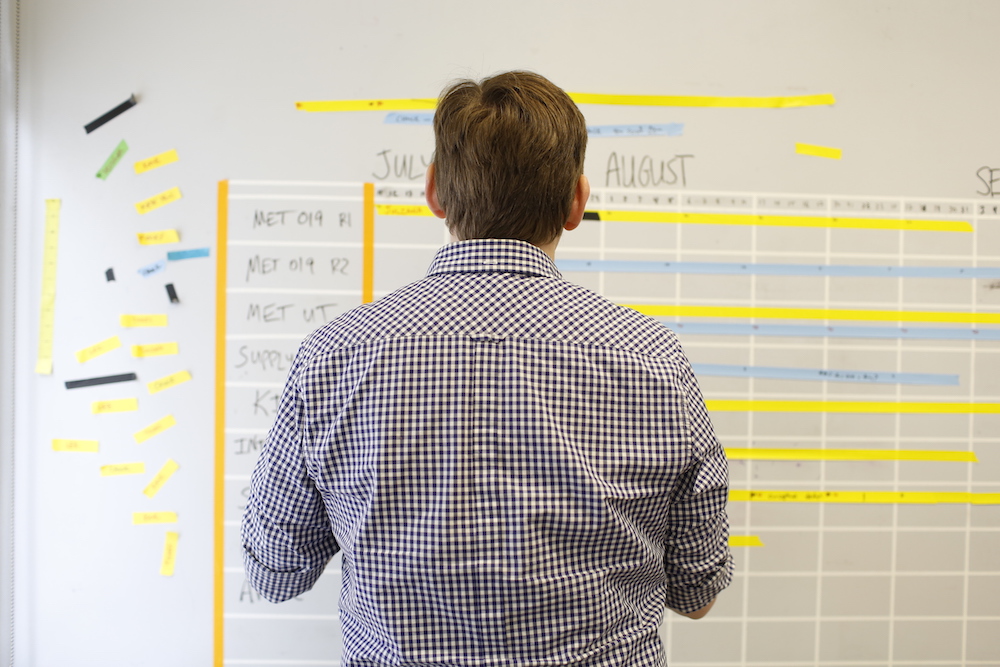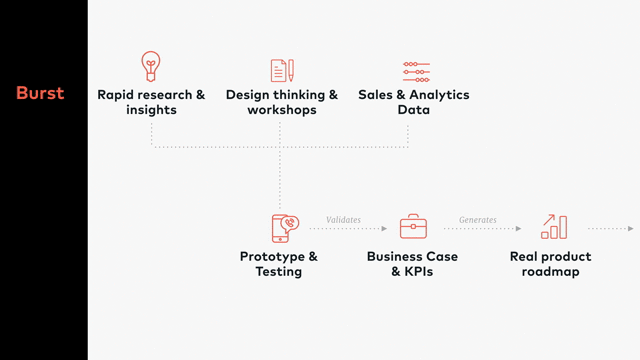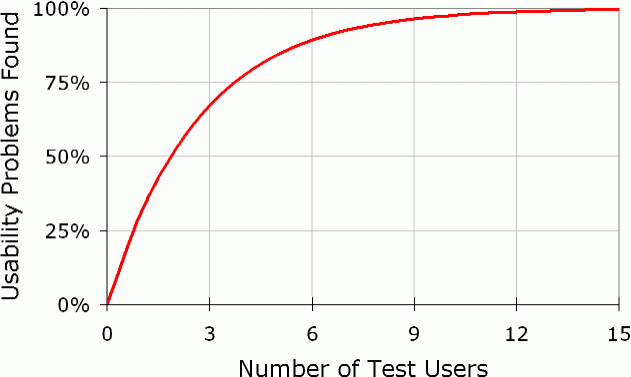
Having headed up a 50-person digital agency for the past 15 years, each and every year I am more and more amazed by how much we are able to accomplish for our clients with our small team of extraordinary talent. As we take on bigger and bigger projects, we become increasingly apt at being able to do more with less. There are a lot of factors that contribute to this. We owe a lot of it to our tools, from software that allows us to conduct user testing digitally that once would have been conducted in person, saving us hours of time and costly resources, to programs like Invision, which allow us to prototype and test in a fraction of the time it once took. But as the tools have changed, so have we. And what has actually been most impactful for our business and what we deliver to our clients, is changing the way the we work–iteratively and regularly. Below are a few ways we have learned how to accomplish more with less.
Ditch Discovery – It’s time to Burst & Build
Spend no more than 3 weeks on your planning process.
A number of years ago we got really, really good at project Discovery. We developed an ironclad process, flexible enough to adapt to any enterprise initiative, yet structured enough to yield meaningful business results every time. Clients loved our Discovery process, during which we helped them to understand how they needed to transform their organizations and that Digital was a means to do so. The list of things we produced during Discovery was intense: project briefs, steering documents, roadmaps, conceptual process flows, user research summaries, stakeholder interviews, RACI/RAPID matrices, technology and infrastructure diagrams, advocacy videos, faceted feature analyses, and much much more! And it always took about 3 months. Sometimes longer!
But, times have changed and Digital is no longer a thing; today Digital is more of the notion that commercial priorities, technology, and designing experiences around customers have all converged. So, enter the need for a new methodology, one that we call Burst & Build.
Burst & Build grew out of a few needs:
- Bringing products to market faster
- Demonstrating to executive sponsors at large corporations that their continued investment in the project is yielding positive return on equity
- Avoiding (or actually making) mistakes earlier
- Protecting the “back half” of the project budget that can get inadvertently directed to wasteful Discovery activities
- Bringing Development resources to the table sooner
- Having more fun…because we’re really all in this to build things

How fast can you move?
3 weeks. We keep challenging ourselves to balance thinking expansively and carefully against getting sh*t done, and have been landing on about 3 weeks as the right amount of time.
On a recent engagement we had to dramatically improve a customer’s ability to understand a client’s product offering on their ecommerce site in a highly competitive consumer electronics segment. Here’s how we segmented our time:

Stay tuned to our newsfeed for more on this topic.
Move Radically Fast – For real, don’t just say that you do
Inviting all stakeholders to the formative stages of a project allows us to make very fast decisions and accelerates the product development lifecycle.
Corporate bureaucracies, with their entrenched hierarchies and protocols, can too often become an impediment to speed. In our work, design studios involving a project’s key stakeholders have proved to be an effective method to help teams bypass some of the traditional roadblocks that so often slow a project down and quickly ideate solutions to be tested and validated so we can keep moving.
Working in this fashion, without all of the safeguards corporate protocols provide, is going to be uncomfortable for people who are new to the process, but it’s important not to let this slow you down, as that defeats the point. You have to find ways to support your clients as they jump in with two feet.
We experienced this first hand with one of our insurance clients. We work a lot in the insurance industry–an industry with a reputation for being slow, mired in bureaucracy, and behind the times (we’re in the process of changing that!). Running design studios in these kinds of environments can be tricky. A few minutes into our first design studio with this client, one of the project leads pulled us out of the session to express his concern as to whether the design studio was actually going to work with his team, most of whom seemed very skeptical. We reassured him, crossed our fingers, and doubled down.
One method we have used to overcome typical corporate/big company objections, is putting in place the rigid RACI/RAPID decision-making frameworks these folks used to–in fact this will make them even more effective.
Not only did the design studio generate the ideas that are now functioning and live on our client’s website and doing wonders for their business, but the design studio left a lasting mark upon how our client now runs projects and thinks about innovation. The same project lead who initially expressed his concern recently connected with us to begin working with them on a proposal to help them build out an internal team of people who can conduct design studios and lead rapid innovation themselves, within their organization.
Using design studios to reshape corporate culture and empower your clients with the techniques they need to move quickly themselves will help you move from saying that you move fast, to actually doing it.
Smaller Teams > Bigger Teams – And staff them with subject matter experts, not generalists
Don’t attempt to build a new product without deep industry expertise. Your fancy UX chops really aren’t enough to go it alone. You need subject matter experts.
One of the worst mistakes we see other agencies and our clients make is to try to bring too many people onto a project, thinking the more perspectives they have the better the project will be. In our experience it’s the opposite. Smaller teams are far superior, but they have to be staffed with the right people, namely those with the deepest industry expertise. If you don’t have the commercial expertise in house, go out and find it.
At Cake & Arrow we pride ourselves on deep expertise within our key verticals, particularly insurance and ecommerce. Being able to speak the language of our clients and talk to them like we are in the field goes a long way in terms of being able to get started (and delivering) quickly–we don’t have to come up the learning curve–and are able to come to the table with valuable first-hand industry insights gleaned from our project work.
Thanks to our deep experience working on insurance and a small group of subject matter experts we recruited, on a recent interface design for an insurance sales system it took us 2 weeks to design and complete the entire system.
It’s amazing how bringing in an expert can accelerate one’s own thinking on the topic and the quality of your experience work. After all, it’s not only all about the user – we’re building software products to accomplish business needs and an expertise in a space is required to truly deliver results on a CX investment.
Set Dates With Consequences – Missing a deadline should have serious bite to it
Absolutely strict deadlines are required to force the business, product owners, and technology to all come to the table to prioritize product requirements.
A few years ago we were involved in a multi-year launch of a new global product with a Fortune 100 company. The project deadline was always soft. Human beings are naturally procrastinators, and companies, especially those made up of thousands of people, are no different: if you always have more time, you’ll always need more time.
Because the project lacked a hard deadline, it continued to have delays, until finally an ultimatum was placed: the project had to launch by a specific date, or else it wouldn’t launch at all. Once a final ultimatum was placed, priorities fell in line and we were able to get the business and IT to both come to the table and prioritize their requirements, and make the hard decisions about what was needed for the initial launch. 3 months later we were in market.
While setting hard deadlines can be scary and even risky, it’s oftentimes the only way to get project teams to truly prioritize and make the tough decisions necessary to complete the project.
5 Users is Enough (Most of the Time) – Channel your inner Jakob Nielsen
Testing your new experiences early and often with small sets of users will uncover most usability problems. And it’s not all that expensive to do.
According to Jakob Nielsen, “Elaborate usability tests are a waste of resources. The best results come from testing no more than 5 users and running as many small tests as you can afford.”
Plenty has been written about Nielsen’s claim that you only need 5 users in a qualitative test to uncover the majority of usability problems. We’ve found Nielsen’s 5 users maxim to hold true in the majority of our work. Really. 5 users is generally enough. (As with all things that appear too good to be true, there are some exceptions to this, though the 5 user rule has held up remarkably well over time.)

Source: Why You Only Need to Test with 5 Users
Because setting up a 5 user test is extremely cost efficient we generally run them early and often throughout the product development lifecycle.
In a recent project we conducted with a leading global insurance provider, we recruited a group of 5 Ohio-based insurance agents who served as our testing sample during our early rounds of building out a sales platform for agents. Not only were they instrumental in validating our prototype, but they truly became co-creators, ensuring that the system we built was something agents would actually want to use. In many ways this project serves as a case-study example proving Nielsen’s maxim. Later on in the project we ended up conducting a larger unmoderated study, and the fact that this study validated what we had already learned from our original 5 users proves the point– ”the best results come from testing no more than 5 users and running as many small tests as you can afford.”
To do more with less doesn’t take much. In just 3 weeks, with a small team of experts, 5 users and the right innovation techniques and project parameters in place, we’ve discovered that you can do a hell of a lot, and do it quickly. It is really a matter of putting your energy into learning how to use the resources you have in the best possible way.
When studying Millennials, one of our research hypotheses was that to deliver value at the highest levels means resonating with Millennial values, that is, the important and lasting beliefs that influence their behaviors, attitudes, and priorities. Our research identified three key values driving Millennials: Community & Authentic Connect, Interdependency & Social Good, Transparency & Autonomy. Through a sequence of ideation, design, and user testing we were able to validate that insurance products that resonate with these values ultimately deliver more value (and higher level value) to Millennials than traditional insurance products, fundamentally changing the way they think about insurance.